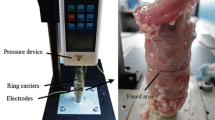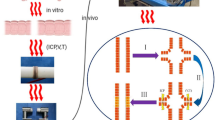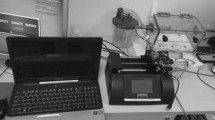Abstract
Background
Bipolar radiofrequency (RF) induced tissue fusion is believed to have the potential to seal and anastomose intestinal tissue thereby providing an alternative to current techniques which are associated with technical and functional complications. This study examines the mechanical and cellular effects of RF energy and varying compressive pressures when applied to create ex vivo intestinal seals.
Methods
A total of 299 mucosa-to-mucosa fusions were formed on ex vivo porcine small bowel segments using a prototype bipolar RF device powered by a closed-loop, feedback-controlled RF generator. Compressive pressures were increased at 0.05 MPa intervals from 0.00 to 0.49 MPa and RF energy was applied for a set time period to achieve bowel tissue fusion. Seal strength was subsequently assessed using burst pressure and tensile strength testing, whilst morphological changes were determined through light microscopy. To further identify the subcellular tissue changes that occur as a result of RF energy application, the collagen matrix in the fused area of a single bowel segment sealed at an optimal pressure was examined using transmission electron microscopy (TEM).
Results
An optimal applied compressive pressure range was observed between 0.10 and 0.25 MPa. Light microscopy demonstrated a step change between fused and unfused tissues but was ineffective in distinguishing between pressure levels once tissues were sealed. Non uniform collagen damage was observed in the sealed tissue area using TEM, with some areas showing complete collagen denaturation and others showing none, despite the seal being complete. This finding has not been described previously in RF-fused tissue and may have implications for in vivo healing.
Conclusions
This study shows that both bipolar RF energy and optimal compressive pressures are needed to create strong intestinal seals. This finding suggests that RF fusion technology can be effectively applied for bowel sealing and may lead to the development of novel anastomosis tools.





Similar content being viewed by others
References
Chu C, Williams DF (1984) Effects of physical configuration and chemical structure of suture materials on bacterial adhesion. A possible link to wound infection. Am J Surg 147:8
Fielding LP, Stewart-Brown S, Blesovsky L, Kearney G (1980) Anastomotic integrity after operations for large-bowel cancer: a multicenter study. Br Med J 281:411–414
Neutzling CB, Lustosa SAS, Proenca IM, da Silva EMK, Matos D (2012) Stapled versus handsewn methods for colorectal anastomosis surgery. Cochrane Database Syst Rev 2:CD003144
Sauer JS, Hinshaw JR, Mcguire KP (1989) The 1st sutureless, laser-welded, end-to-end bowel anastomosis. Lasers Surg Med 9:70–73
Cilesiz I, Thomsen S, Welch AJ (1997) Controlled temperature tissue fusion: argon laser welding of rat intestine in vivo. Part one. Lasers Surg Med 21:269–277
Bass LS, Treat MR (1995) Laser tissue welding: a comprehensive review of current and future clinical applications. Lasers Surg Med 17:315–349
Wills E, Crawford G (2013) Clipless versus conventional laparoscopic cholecystectomy. J Laparoendosc Adv Surg Tech A 23(3):237–239
Lang BH, Ng SH, Lau LL, Cowling BJ, Wong KP (2013) A systematic review and meta-analysis comparing the efficacy and surgical outcomes of total thyroidectomy between harmonic scalpel versus LigaSure. Ann Surg Oncol. doi:10.1245/s10434-012-2849-6
Macario A, Dexter F, Sypal J, Cosgriff N, Heniford BT (2008) Operative time and other outcomes of the electrothermal bipolar vessel sealing system (LigaSure) versus other methods for surgical hemostasis: a meta-analysis. Surg Innov 15:284–291
Waraich N, Ahmed J, Rashid F, Mulvey D, Leeder P, Iftikhar SY (2009) Is harmonic scalpel an effective tool for oesophagectomy? Int J Surg 7:330–333
Kennedy JS, Stranahan PL, Taylor KD, Chandler JG (1998) High-burst-strength, feedback-controlled bipolar vessel sealing. Surg Endosc 12:876–878
Kennedy JS, Buysse SP, Lawes KR, Ryan TP (1999) Recent innovations in bipolar electrosurgery. Minim Invasive Ther Allied Technol 8:95–99
Richter S, Kollmar O, Neunhoeffer E, Schilling MK, Menger MD, Pistorius G (2006) Differential response of arteries and veins to bipolar vessel sealing: evaluation of a novel reusable device. J Laparoendosc Adv Surg Tech A 16:149–155
Landman J, Kerbl K, Rehman J, Andreoni C, Humphrey PA, Collyer W, Olweny E, Sundaram C, Clayman RV (2003) Evaluation of a vessel sealing system, bipolar electrosurgery, harmonic scalpel, titanium clips, endoscopic gastrointestinal anastomosis vascular staples and sutures for arterial and venous ligation in a porcine model. J Urol 169:697–700
Yang HR, Wang YC, Chung PK, Jeng LB, Chen RJ (2005) Laparoscopic appendectomy using the LigaSure vessel sealing system. J Laparoendosc Adv Surg Tech A 15:353–356
Ikeda M, Hasegawa K, Sano K, Imamura H, Beck Y, Sugawara Y, Kokudo N, Makuuchi M (2009) The vessel sealing system (LigaSure) in hepatic resection: a randomized controlled trial. Ann Surg 250:199–203
Shigemura N, Akashi A, Nakagiri T, Ohta M, Matsuda H (2004) A new tissue-sealing technique using the LigaSure system for nonanatomical pulmonary resection: preliminary results of sutureless and stapleless thoracoscopic surgery. Ann Thorac Surg 77:1415–1418
Palazzo FF, Francis DL, Clifton MA (2002) Randomized clinical trial of LigaSure (TM) versus open haemorrhoidectomy. Br J Surg 89:154–157
Yao HS, Wang Q, Wang WJ, Ruan CP (2009) Prospective clinical trials of thyroidectomy with LigaSure vs conventional vessel ligation: a systematic review and meta-analysis. Arch Surg 144:1167–1174
Lee WJ, Chen TC, Lai IR, Wang W, Huang MT (2003) Randomized clinical trial of LigaSure versus conventional surgery for extended gastric cancer resection. Br J Surg 90:1493–1496
Romano F, Caprotti R, Franciosi C, De Fina S, Colombo G, Uggeri F (2002) Laparoscopic splenectomy using LigaSure. Preliminary experience. Surg Endosc 16:1608–1611
Takada M, Ichihara T, Kuroda Y (2005) Comparative study of electrothermal bipolar vessel sealer and ultrasonic coagulating shears in laparoscopic colectomy. Surg Endosc 19:226–228
Harold KL, Pollinger H, Matthews BD, Kercher KW, Sing RF, Heniford BT (2003) Comparison of ultrasonic energy, bipolar thermal energy, and vascular clips for the hemostasis of small-, medium-, and large-sized arteries. Surg Endosc 17:1228–1230
Schulze S, Damgaard B, Jorgensen LN, Larsen SS, Kristiansen VB (2010) Cystic duct closure by sealing with bipolar electrocoagulation. JSLS 14:20–22
Pai M, Jiao LR, Khorsandi S, Canelo R, Spalding DR, Habib NA (2008) Liver resection with bipolar radiofrequency device: Habib 4X. HPB (Oxford) 10:256–260
Abbas G, Pennathur A, Landreneau RJ, Luketich JD (2009) Radiofrequency and microwave ablation of lung tumors. J Surg Oncol 100:645–650
Holmer C, Winter H, Kroger M, Nagel A, Jaenicke A, Lauster R, Kraft M, Buhr HJ, Ritz JP (2011) Bipolar radiofrequency-induced thermofusion of intestinal anastomoses-feasibility of a new anastomosis technique in porcine and rat colon. Langenbecks Arch Surg 396:529–533
Winter H, Holmer C, Buhr HJ, Lindner G, Lauster R, Kraft M, Ritz JP (2010) Pilot study of bipolar radiofrequency-induced anastomotic thermofusion-exploration of therapy parameters ex vivo. Int J Colorectal Dis 25:129–133
Smulders JF, de Hingh IH, Stavast J, Jackimowicz JJ (2007) Exploring new technologies to facilitate laparoscopic surgery: creating intestinal anastomoses without sutures or staples, using a radio-frequency-energy-driven bipolar fusion device. Surg Endosc 21:2105–2109
Salameh JR, Schwartz JH, Hildebrandt DA (2006) Can LigaSure seal and divide the small bowel? Am J Surg 191:791–793
Wallwiener CW, Rajab TK, Zubke W, Isaacson KB, Enderle M, Schaller D, Wallwiener M (2008) Thermal conduction, compression, and electrical current-an evaluation of major parameters of electrosurgical vessel sealing in a porcine in vitro model. J Minim Invasive Gynecol 15:605–610
Nelsen TS, Anders CJ (1966) Dynamic aspects of small intestinal rupture with special consideration of anastomotic strength. Arch Surg 93:309–314
Hendriks T, Mastboom WJ (1990) Healing of experimental intestinal anastomoses. Parameters for repair. Dis Colon Rectum 33:891–901
Engel J, Bachinger HP (2005) Structure, stability and folding of the collagen triple helix. Topics in current Chemistry: collagen. Springer, Berlin, pp 7–33
Schober R, Ulrich F, Sander T, Durselen H, Hessel S (1986) Laser-induced alteration of collagen substructure allows microsurgical tissue welding. Science 232:1421–1422
Bass LS, Moazami N, Pocsidio J, Oz MC, LoGerfo P, Treat MR (1992) Changes in type I collagen following laser welding. Lasers Surg Med 12:500–505
Tang J, Godlewski G, Rouy S, Delacretaz G (1997) Morphologic changes in collagen fibers after 830 nm diode laser welding. Lasers Surg Med 21:438–443
Acknowledgments
The authors acknowledge the help of Dr. Michael Hollinshead of the Wellcome Imaging Centre, St. Mary’s Hospital, Imperial College London, in obtaining the transmission electron micrographs presented in this study, and Dr. Melody Ni of the Department of Surgery, Academic Surgical Unit, St. Mary’s Hospital, Imperial College London, in advising the statistical analysis presented.
Disclosures
This report is independent research funded by the Department of Health under the Health Technology Devices programme (HTD240). The views expressed in this publication are those of the authors and not necessarily those of the NHS or the Department of Health. Mr. Arya, Dr. Lei, Mrs. Kudo, and Professor Hanna receive funding from the UK Department of Health and Covidien under the Health Technology Devices programme (HTD240). Ms. Hadjievangelou, Dr. Elson, and Professors Goldin and Darzi have no conflicts of interest or financial ties to disclose.
Author information
Authors and Affiliations
Corresponding author
Rights and permissions
About this article
Cite this article
Arya, S., Hadjievangelou, N., Lei, S. et al. Radiofrequency-induced small bowel thermofusion: an ex vivo study of intestinal seal adequacy using mechanical and imaging modalities. Surg Endosc 27, 3485–3496 (2013). https://doi.org/10.1007/s00464-013-2935-2
Received:
Accepted:
Published:
Issue Date:
DOI: https://doi.org/10.1007/s00464-013-2935-2




